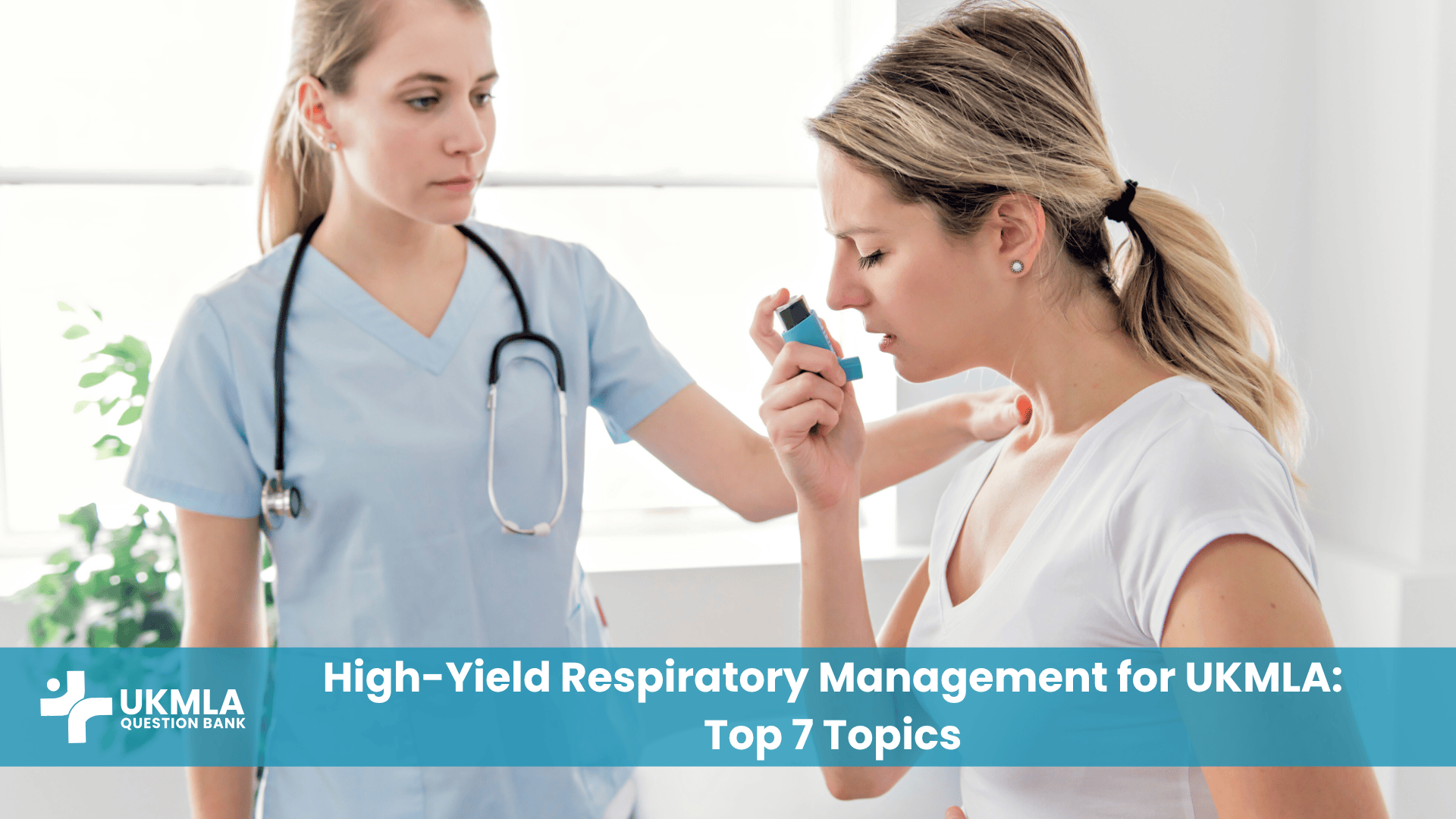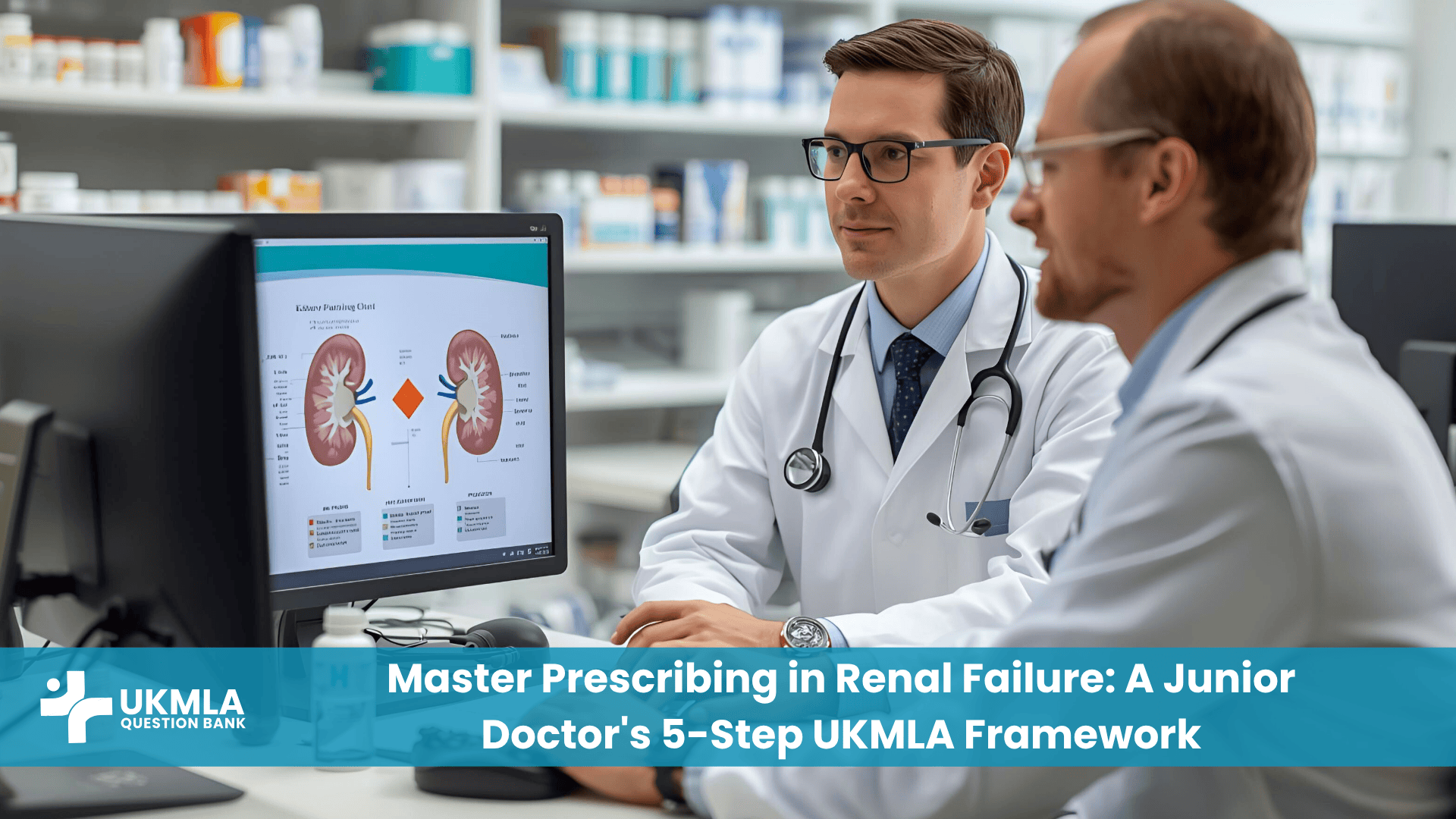Introduction
Mastering high-yield respiratory management for UKMLA is a fundamental requirement for success in the Applied Knowledge Test (AKT). Respiratory conditions are ubiquitous in medicine, presenting in settings from the GP surgery to the emergency department. The UKMLA will rigorously test your ability to manage these common and often life-threatening scenarios, focusing on the entire clinical pathway from accurate diagnosis and investigation to safe and effective treatment.
This guide is designed to be your essential resource for this core topic. We will provide a focused, structured approach to the 7 most critical respiratory conditions you need to know. By understanding these key areas and their management principles, you will build the confidence to deconstruct any respiratory-based SBA (Single Best Answer) question and demonstrate your readiness for safe practice.
Table of Contents
ToggleThe Top 7 Topics for High-Yield Respiratory Management for UKMLA
To succeed in this domain, you must structure your revision. These seven key areas provide a framework that covers the vast majority of respiratory questions you will face.
1. Asthma
Asthma is a chronic inflammatory disease of the airways characterised by reversible bronchoconstriction.
Key Features: The classic presentation is a triad of diurnal variation (symptoms worse at night or early morning), a persistent dry cough, and expiratory wheeze. It’s crucial to ask about triggers (e.g., cold air, exercise, allergens) and any personal or family history of atopy (eczema, hay fever).
Essential Investigations: The gold standard is spirometry with reversibility testing. A significant improvement in FEV1 (Forced Expiratory Volume in 1 second) after administering a bronchodilator is diagnostic. Other useful tests include Peak Expiratory Flow (PEF) diaries and Fractional exhaled Nitric Oxide (FeNO) testing.
Management Principles: Management follows a stepwise ladder, as outlined in the definitive British Thoracic Society (BTS) / SIGN guideline. The goal is to achieve complete control. This starts with a short-acting beta-agonist (SABA, e.g., Salbutamol) as a reliever, followed by the introduction of a regular low-dose inhaled corticosteroid (ICS, e.g., Beclometasone) as a preventer. Steps are added as needed, such as a long-acting beta-agonist (LABA). Management of an acute exacerbation involves high-flow oxygen, nebulised bronchodilators, and systemic steroids (oral prednisolone or IV hydrocortisone).
2. Chronic Obstructive Pulmonary Disease (COPD)
COPD is a progressive and largely irreversible obstructive lung disease, almost always caused by smoking.
Key Features: The typical patient is an older adult with a significant smoking history, presenting with progressive shortness of breath and a productive cough. It’s vital to differentiate it from asthma.
Table 1: Differentiating Asthma vs. COPD
| Feature | Asthma | COPD |
|---|---|---|
| Age of Onset | Typically childhood/young adult | Typically > 40 years old |
| Smoking History | Not a direct cause | Almost always present |
| Symptom Pattern | Variable, often with clear triggers and diurnal variation | Chronic and progressive |
| Spirometry | Obstructive pattern with significant reversibility | Obstructive pattern (FEV1/FVC < 0.7) with little or no reversibility |
| Inflammation | Eosinophilic | Neutrophilic |
Management Principles: The single most important intervention is smoking cessation. Pharmacological management involves inhaled bronchodilators, starting with a short-acting agent (SABA or SAMA) and escalating to long-acting bronchodilators (LABA and/or LAMA). Management of an acute infective exacerbation involves controlled oxygen, nebulisers, steroids, and antibiotics.
3. Community-Acquired Pneumonia (CAP)
This is an acute infection of the lung parenchyma acquired outside of a hospital setting.
Key Features: Look for an acute onset of cough, fever, purulent sputum, and pleuritic chest pain. On examination, there may be focal signs like bronchial breathing or coarse crackles.
Essential Investigations: A Chest X-ray is key to confirm the diagnosis, which will typically show consolidation. The CURB-65 score is a vital tool for assessing severity and guiding the place of care (home, hospital, or ITU). The score is based on: Confusion, Urea > 7, Respiratory rate ≥ 30, Blood pressure < 90/60, and age ≥ 65. For more on this, our guide on interpreting clinical data is essential.
Management Principles: Antibiotic choice is dictated by the CURB-65 score. A score of 0-1 can usually be managed at home with oral Amoxicillin. A score of 2 requires hospital admission, and a score of 3 or more suggests severe pneumonia requiring intensive management.
4. Pulmonary Embolism (PE)
A PE is an obstruction of the pulmonary artery or one of its branches, usually by a thrombus that has travelled from the deep veins of the legs.
Key Features: The classic presentation is a sudden onset of pleuritic chest pain and shortness of breath. Patients are often tachycardic and tachypnoeic. Look for risk factors for venous thromboembolism (VTE), such as recent surgery, immobility, active cancer, or pregnancy.
Essential Investigations: The diagnostic pathway starts with risk stratification using the Wells score. In a low-risk patient, a negative D-dimer can rule out a PE. In a high-risk patient, the definitive investigation is a CT Pulmonary Angiogram (CTPA).
Management Principles: The immediate management for a suspected or confirmed PE is therapeutic anticoagulation, typically started with a low-molecular-weight heparin (LMWH) injection while awaiting definitive imaging.
5. Lung Cancer
Lung cancer is the leading cause of cancer death in the UK.
Key Features: You must be able to recognise the red flag symptoms that warrant an urgent investigation. These include haemoptysis, a persistent cough (especially in a smoker), unexplained weight loss, and chest pain. Also be aware of paraneoplastic syndromes, such as SIADH or Lambert-Eaton syndrome.
Essential Investigations: Any patient with suspected lung cancer requires an urgent Chest X-ray. If this is suspicious, the next step is a staging CT scan of the chest, abdomen, and pelvis, followed by a biopsy for histological diagnosis.
Management Principles: Know the basic difference between Small Cell Lung Cancer (SCLC), which is typically treated with chemotherapy, and Non-Small Cell Lung Cancer (NSCLC), where surgery may be an option in early-stage disease. All cases must be discussed in a specialist multidisciplinary team (MDT) meeting.
6. Pleural Effusion
A pleural effusion is an abnormal collection of fluid in the pleural space.
Key Features: The main symptom is progressive shortness of breath. On examination, there will be reduced breath sounds, reduced chest expansion, and a “stony dull” percussion note at the affected lung base.
Essential Investigations: A Chest X-ray will show blunting of the costophrenic angle and a meniscal fluid level. The most important investigation is a diagnostic pleural tap (thoracentesis) to analyze the fluid. You must know the difference between a transudate (low protein, caused by systemic factors like heart failure) and an exudate (high protein, caused by local factors like infection or malignancy), which is determined by Light’s criteria.
Management Principles: The ultimate management is to treat the underlying cause. For large, symptomatic effusions, a therapeutic aspiration or a chest drain can provide significant relief.
7. Pneumothorax
A pneumothorax is air in the pleural space, causing the lung to collapse.
Key Features: The classic presentation is a sudden onset of pleuritic chest pain and shortness of breath, often in a tall, thin young man (primary spontaneous pneumothorax) or a patient with underlying lung disease like COPD (secondary pneumothorax).
Essential Investigations: A Chest X-ray will show a collapsed lung edge with no lung markings beyond it. It is critical to look for signs of a tension pneumothorax, a life-threatening emergency where air is trapped in the pleural space, causing mediastinal shift and haemodynamic compromise. This is a clinical diagnosis.
Management Principles: The management depends on the size of the pneumothorax and whether the patient is symptomatic. Small pneumothoraces may be managed conservatively. Larger or symptomatic ones often require aspiration or the insertion of a chest drain. A tension pneumothorax requires immediate needle decompression in the second intercostal space, mid-clavicular line. For more on this, see our guide on Emergency Medicine Essentials.
Clinical Pearl: “In any acutely breathless patient, your initial differential should always include the life-threatening causes: tension pneumothorax, pulmonary embolism, acute severe asthma, and acute pulmonary oedema. Your ABCDE assessment is designed to identify and manage these immediately.”
Applying Respiratory Principles to UKMLA Questions
SBA (Single Best Answer) questions in this area will test your ability to apply these principles.
Interpreting Spirometry and ABGs: You will be expected to look at a set of spirometry results and identify an obstructive or restrictive pattern. Similarly, you must be able to interpret an Arterial Blood Gas (ABG) to identify hypoxia and determine the type of respiratory failure or acid-base disturbance.
Choosing the “Most Appropriate Next Step”: Many questions will ask for the next step in management. This requires you to have assessed the severity of the condition (e.g., using the CURB-65 score for pneumonia) and to know the established treatment pathways. For more on this, our guide on tackling SBAs effectively is a crucial resource.
Frequently Asked Questions (FAQ): Respiratory Management
Type 1 Respiratory Failure is defined by hypoxia (low PaO₂) with a normal or low PaCO₂. It is caused by a V/Q mismatch (e.g., in pneumonia or PE). Type 2 Respiratory Failure is defined by hypoxia (low PaO₂) with hypercapnia (high PaCO₂). It is caused by alveolar hypoventilation (e.g., in severe COPD or due to opioid overdose).
It’s a simple scoring system where one point is given for each of: Confusion (new), Urea > 7 mmol/L, Respiratory Rate ≥ 30, Blood Pressure (systolic < 90 or diastolic ≤ 60), and age ≥ 65. A score of 0-1 suggests outpatient treatment, 2 suggests hospital admission, and ≥3 suggests severe pneumonia and consideration of ITU admission.
LTOT is prescribed for patients with chronic, severe hypoxaemia to improve survival. The criteria generally require a PaO₂ of < 7.3 kPa, or a PaO₂ of 7.3-8.0 kPa with evidence of end-organ damage like pulmonary hypertension. The patient must be a non-smoker.
A CTPA (CT Pulmonary Angiogram) is the first-line imaging test for most patients as it provides a direct image of the clot. A V/Q (Ventilation/Perfusion) scan is a nuclear medicine scan that is often used in patients who cannot have a CTPA (e.g., due to renal impairment or contrast allergy).
A transudate is caused by imbalances in hydrostatic or oncotic pressure (e.g., heart failure, liver failure) and has a low protein content. An exudate is caused by inflammation of the pleura (e.g., infection, malignancy) and has a high protein content. Light’s criteria are used to differentiate them based on fluid and serum protein and LDH levels.
This is the anatomical landmark for safe chest drain insertion to avoid major structures. The borders are the lateral edge of the pectoralis major muscle, the anterior edge of the latissimus dorsi muscle, and a horizontal line from the nipple (the 5th intercostal space).
This is an acute medical emergency. If a patient is not responding to initial nebulisers and steroids, they need senior medical review immediately. Further management can include IV magnesium sulphate, IV aminophylline, and consideration of admission to a high dependency or intensive care unit.
The most common local side effects are oral candidiasis (thrush) and dysphonia (a hoarse voice). These can be minimised by using a spacer device and rinsing the mouth after use.
No. This is a common misconception. Hypoxia kills, whereas hypercapnia is generally better tolerated in the short term. The correct approach is not to stop the oxygen, but to titrate it carefully to a target saturation range (usually 88-92% for patients at risk of Type 2 respiratory failure), aiming for the lowest oxygen concentration that achieves this.
Understand the core pathophysiology of the 7 key conditions in this guide. Then, use a high-quality UKMLA question bank to practice applying this knowledge to clinical vignettes, paying close attention to the interpretation of investigations like spirometry and ABGs.
Conclusion
Mastering high-yield respiratory management for UKMLA is about developing a systematic and safe approach to common and critical conditions. From the chronic management of asthma and COPD to the acute recognition of a pulmonary embolism or tension pneumothorax, the principles of careful assessment, appropriate investigation, and evidence-based treatment are key.
By structuring your revision around these 7 core topics and focusing on the “why” behind each management step, you will be well-prepared to demonstrate your competence in the AKT. Remember to always prioritise patient safety, use scoring systems like CURB-65 to guide your decisions, and never hesitate to escalate care for a deteriorating patient.




